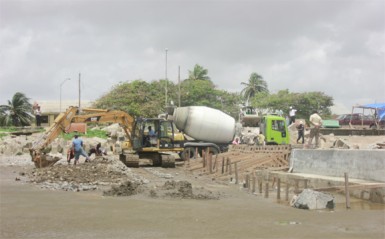The Public Works Ministry is constructing two new groynes and rehabilitating an additional two groynes along the seawall stretching from Kingston to Camp Road.
Construction of the structures will cost the ministry approximately $20 million; the new groynes are expected to cost $6 million while rehabilitation was contracted at $4 million. Chief Sea and River Defence Officer Geoffrey Vaughn told Stabroek News that the cost at this point was relatively low because the ministry was responsible for the construction materials.
“We have all of that stockpiled, so materials don’t always factor into the cost. We have the stone and the cement. If we were buying materials, yeah it would be significantly more. But right now we aren’t looking at that,” he said.

Vaughn stated that the reconstruction and the new construction were necessary to provide wave breakers. He said the groynes, along with the rip-rap that is being placed along the aging seawall, will significantly reduce erosion.
Vaughn stated that the older stretches of the seawall suffered from large amounts of erosion and the travelling phenomena of overtopping that first began along Montrose, East Coast Demerara is expected to hit the Kingston area in the next few months. He noted that because of the area, the groynes were the most resourceful measure to breaking the water before it reaches the coast.
Vaughn said the new groynes will be built significantly higher than the two current structures that are undergoing rehabilitation. When Stabroek News visited the construction site, it was clear that the amount of shells and mud that had been washed along the seawall would soon cover one of the existing groynes closest to Camp Road.
Vaughn said this was a primary reason behind rehabilitation of the current structures. “When you look over there you can see all the shells… We are building higher because the groyne still needs to break the waves as they come in,” he said.
He further noted that the while the shells and mud were expected and were a good sign that the weather pattern was easing and travelling, the sea defences along the area needed to be constructed to prevent further erosional damage to the old seawall.

Vaughn noted that the while other materials are often used to build groynes Guyana did not want to incur additional charges down the road. Wooden groynes were thought about, but the type of timber used cannot be dried sufficiently in Guyana and as a result the wear and tear on the wood would be far greater than the stone and cement. He told Stabroek News that for much of sea defence, the size and materials used had to be thought of. He motioned toward the “T” shaped stones being used as rip-rap along the area and note that the ministry would be assessing how better these stones worked compared to others along the coast.
Minister of Transport and Hydraulics Robeson Benn stated that rip-rap of this nature costs around $1 billion for a three-kilometre area so other ventures were being looked at before using rip-rap along the entire coast. Benn said that the current rip-rap was being done on a two to four feet slope and that was proving to be the best dimension for breaking waves prior to the water reaching the wall and eroding the mud shore. He said there were alternatives such as mangroves which are significantly cheaper and provide protection.
Benn stated that for years, sea defence maintenance was not done and as a result the amount of work that currently needs to be done is fiscally not feasible in a year. He said the mud shore was going to keep travelling along the coast towards Kingston and groyne construction was beginning in that area as a preventative measure. While mild flooding has been an issue, the damage was not as significant as in years past.
Benn noted that the amount of stone currently stockpiled was sufficient to complete construction work on the four groynes but noted that Guyana was suffering from a shortage of stone when works were contracted. He said contractors had to provide the materials when the job went to tender and the materials need were not so readily available for projects. Material had been imported from St Vincent.
However, Benn also noted that to date the ministry had been able to cut the cost of sea defences per linear metre from $3,500 to $2,000. He said this showed that work was being done and the amount of work was keeping costs manageable.
If the erosion moved to Kingston it could possibly threaten major properties like the Pegasus Hotel and the new Marriott Hotel.
In a letter in yesterday’s edition of Stabroek News, engineer Charles Sohan noted that Benn was looking to build groynes as he had noticed that these were assisting to break the waves as was evident at the Carifesta Avenue groyne (CAG) just north of Kitty Pump Station. Sohan said “Construction of groynes on oceanic coasts were not intended to break wave action, but to trap/prevent the drift or movement of material (sand and shell) along the coast due to the action of littoral current. The breaking/dampening of waves as was observed at CAG was due primarily to the presence of sand/shell banks trapped around the groyne because of the accretion taking place at this location, as well as the movement of sling-mud westwards. There is no supporting data per se to corroborate Minister Benn’s claim that groynes are the proper means to prevent large scale erosion or the dampening/ breaking of wave action along the coast and he should stay his assertion and make an informed judgement when the present erosion cycle reaches the CAG location some time soon.”




